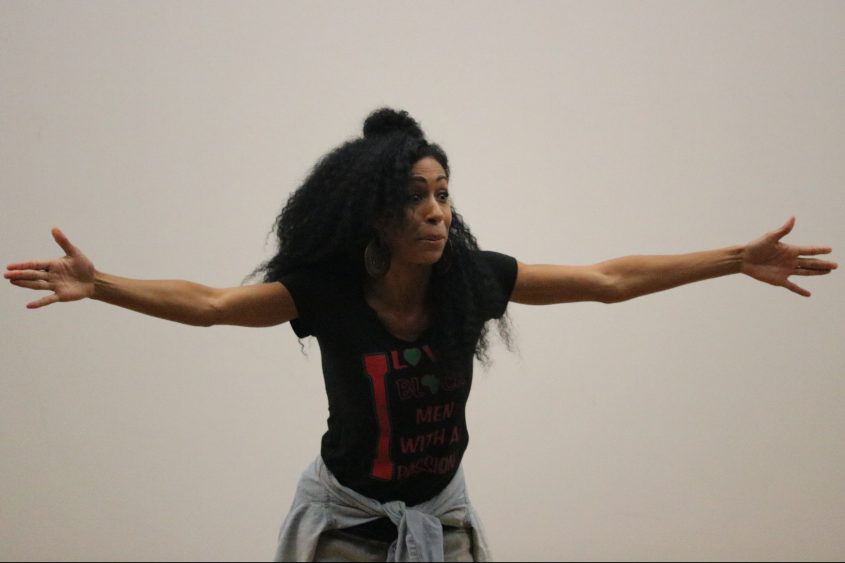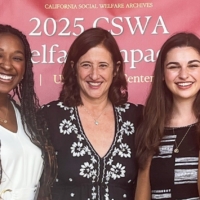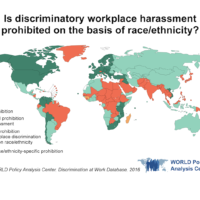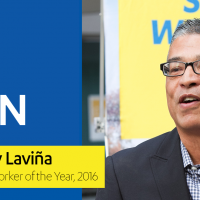
‘Minority Report’ Hits Major Racial Themes Scott St. Patrick’s Luskin-sponsored performance provides a no-holds-barred look at race in America through the centuries
By Zev Hurwitz
It can be difficult to truly empathize with another community’s narrative. Tragedies and injustices toward a racial group only resonate up to a point for those not directly impacted. But true empathy cannot be felt without experiencing the narrative up close.
Scott St. Patrick and his company brought the black American experience up close to a diverse crowd of nearly 200 students and community members when they took to the stage in the Broad Art Center.
Sponsored by the Department of Social Welfare at the UCLA Luskin School of Public Affairs, “Minority Report” is a nine-vignette journey through the black experience in America. Each act was a solo piece by one of seven actors articulating a narrative that touched on a different area of the history of black Americans.
“In Social Welfare at Luskin, we are committed to struggling with racism as a social justice issue,” Gerry Laviña, director of field education for the Luskin School, said as he opened the evening. “We also acknowledge and will acknowledge tonight that the struggle has gone on for generations and continues today.”
St. Patrick, the show’s creator, led off with an extended poem that addressed some of the program’s hardest-hitting themes. St. Patrick began with an emotionally charged lament of the “epidemic of violence” against African Americans by police, which followed a montage of cellphone footage of recent acts, including the death of Eric Garner by police in which Garner could be heard gasping, “I can’t breathe.”
St. Patrick’s opening monologue, which slammed a system in which African Americans are predisposed to institutionalized racism toward blacks and drew parallels with the shooting of the Cincinnati Zoo’s gorilla, Harambe, set the tone for the following acts.
Several of the most impactful vignettes described historical instances of oppression toward African Americans — both violent and socially oppressive. Detra Hicks lamented the cyclical nature of racism toward blacks in America in a piece that linked the violent 1955 murder of black teenager Emmett Till in Mississippi to the more contemporary killings of Tamir Rice and Jordan Davis.
“Where the hell is peripety?” she exclaimed, referring to the literary device wherein a protagonist’s misfortunes are reversed.
In between each vignette, a clip of relevant video or audio set the tone for the following act. While much of the content focused on graphic illustrations of violent injustices and systematic inequality suffered by blacks, a piece by comedian Donald George probed some of these areas with a touch of humor. He likened the 2016 presidential election to a choice between different sexually transmitted infections in the first fully humorous segment of an otherwise serious series.
Kelly Jenrette discussed civil disobedience in her piece “Mississippi Freedom Democratic Party” and highlighted the story of institutional repression of voting rights activist Fannie Lou Hamer. Jenrette currently stars on television in the Fox series “Pitch,” which follows a fictional African American woman breaking the gender barrier in professional baseball.
In “Black Tulsa,” Marcuis Harris delivered an informative piece on how, even in instances of success for the black community, racism rears its ugly face in a violent and destructive manner. Harris’ piece focused on the destruction of a thriving Tulsa, Okla., black community, which was leveled by supremacists in a “race riot” in 1921.
Even the terminology used to describe these instances is part of the issue, Harris said. “‘Race riot’ implies equal footing,” he said, describing the overnight destruction of Greenwood. “This was terrorism.”
Jaclyn Tokos, the only non-black performer of the evening, described the various points of contention — with both blacks and whites — she has faced as a white woman engaged to a black man.
“You can’t teach someone who to love,” she asserted, following a video of boxing legend Muhammad Ali’s 1971 interview in which he explains why he would never choose to marry outside of his race.
Several performers wore attire related to their performances, though Tokos’ donning of a “Black Lives Matter” t-shirt (her fiancé’s, she said) not only made a strong impact, it also reminded audiences of the times. “Minority Report” was performed at a critical time for race relations in America and to be reminded of this in an aptly named piece, “Interracial Love,” was pivotal to the message.
Tokos was followed by Kiya Roberts, who continued to preach love — between blacks. “I don’t need you, but I want you,” Roberts says to no man in particular in her vignette, “It’s Complicated…” The pursuit of love as a means of resolution to the pain between races was stressed more than once during the performances.
As the evening came to a conclusion, “Minority Report” became a “call to action,” to fight injustice and inequality with the power of love. Audience members were left with an “it’s on us” mentality and affirmation that love truly is the only way forward.
St. Patrick performed in two other acts, including the closing. In “Katrina,” St. Patrick led a multimedia-guided personal drop-in to the conditions inside the Superdome in post-Hurricane Katrina. For several days following the devastating storm in 2005, thousands of New Orleans residents were told to seek shelter at the stadium, having been promised provisions. However, the nearly all-black population housed in the Superdome went largely neglected, with few-to-no rations or supplies brought in, and horrific restroom conditions — all on top of deep emotional trauma.
In the most moving moment of the performance, St. Patrick brought the audience inside the Superdome and shared vivid descriptions of the sights and smells. “Many of you couldn’t even last one minute,” he said. Those who dared to attempt to flee to a neighboring community came across a battalion of armed guards, who blocked access to the relatively well-supplied Jefferson Parish.
As the audience absorbed the horror experienced in the days following Katrina, they were reminded of the underlying message of the evening: What ethnicity is experiencing this travesty? Would the conditions have been the same had the ethnic makeup of those inside the dome been different?
After witnessing nine vignettes of reflection, the audience is more likely to acknowledge the ugly truth that is the “Minority Report.” No. No it would not.



















Leave a Reply
Want to join the discussion?Feel free to contribute!